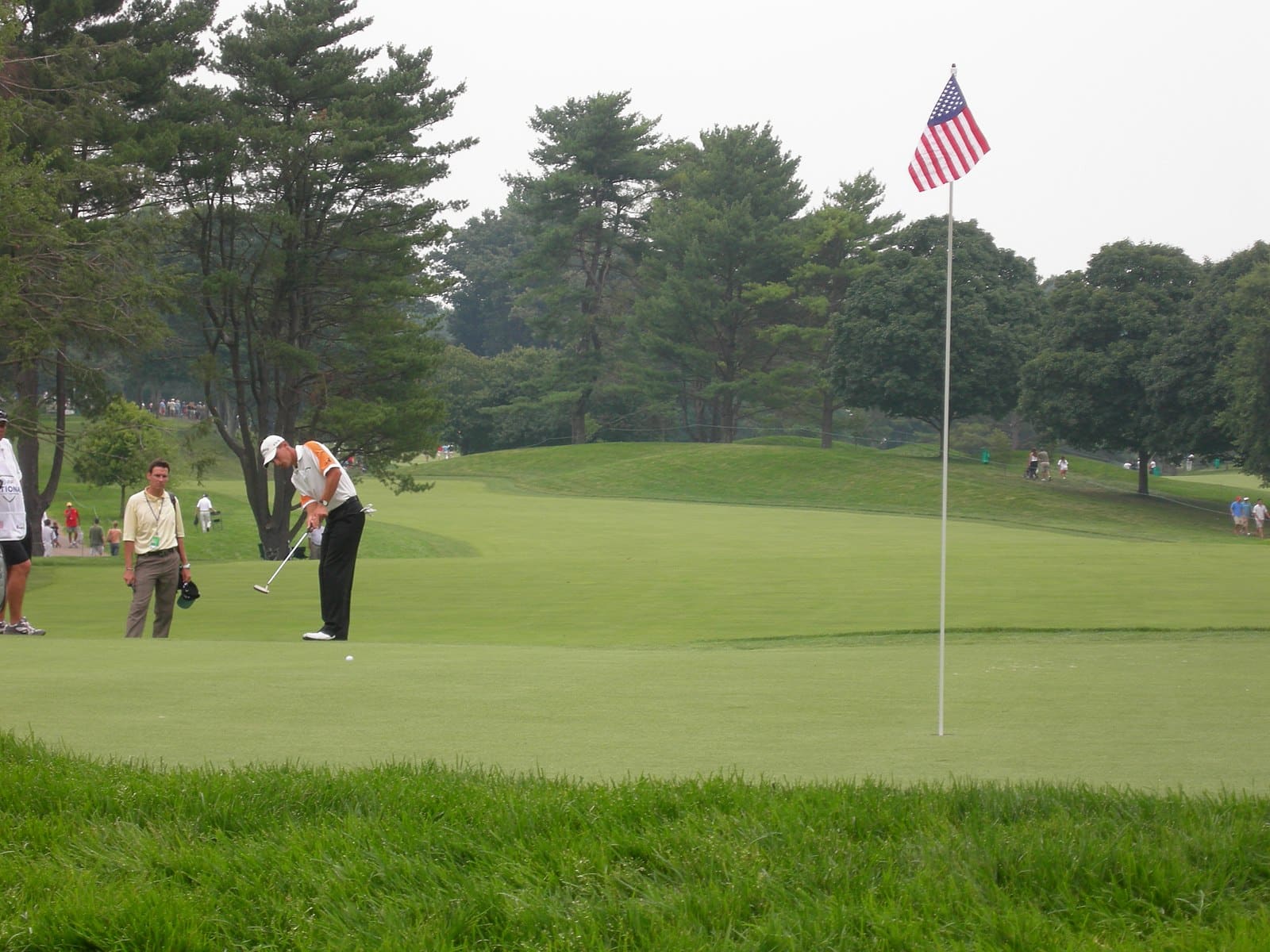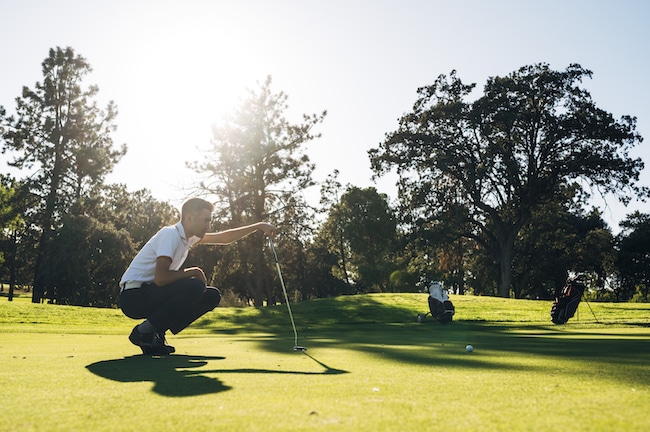Golf is a game of fine margins. You can miss a good putt if it’s only a few centimeters off. Your smashed drive can roll off the fairway and into the thick stuff. The game is so dependent on luck that getting better at it does not always translate to better scores.
This is where different stats come into play. As a general rule of thumb, improving one of these stats can hopefully lead to lower scores. One of the most important stat in golf is Greens in regulation (GIR).
So, what is Greens in regulation (GIR)? Greens in regulation is a stat meaning the number of greens you’ve successfully hit in an 18-hole stretch. With a higher GIR, it’ll be easier to shoot lower scores. You get a greens in regulation point if you hit the green:
- In one shot on a par-3
- In 2 or fewer shots on a par-4
- In 3 or fewer shots on a par-5
But does a high GIR means better scores, or is it a myth?
Let’s dive deeper into how this stat translates to your game and what are some standard GIR percentages among amateurs and professionals.
How Can Hitting Greens in Regulation Help Your Game?

Greens in regulation is a pretty straightforward stat. Suppose you hit all greens in regulation and two-putt every hole; you’ll shoot a par score or better. However, we are talking about golf, so perfection is limited, and luck is always in play.
As the handicap of a golfer rises, the number of greens he hits drops. If the number of greens you can hit in a round drops, the number of birdies or better putts you get also drops, making it hard to shoot lower scores.
Below are average GIR for amateurs:
- +25 handicapper : 3
- 20 – 25 handicapper : 3.5
- 15 – 19 handicapper : 5.1
- 10 – 14 handicapper : 6.9
- 6 – 9 handicapper : 8.5
- 3 – 5 handicapper : 10.2
- 0 – 2 handicapper : 11.8
- +3 – +1 handicapper : 12.6
Essentially, this means that if you want to break ninety, you will at least have to hit 6 to 8 greens. If you’re going to break 80, you will have to hit 9 to 11 greens.
If you’re interested in breaking 80, we’ve written an entire guide on how to break 80 with the right steps.
It’s a myth that better players hit a lot of greens. The above list shows that you do not need to hit an astronomical number of greens to play better rounds. Hitting better scores always comes down to being great around the greens.
However, I was surprised to see the green in regulations numbers across the PGA tour. Seeing how good these professional golfers are at every aspect of the game was eye-opening.
PGA Tour Greens in Regulations Statistics

We are still early into the PGA tour season; however, the PGA tour GIR numbers stay relatively high and remain the same, although leaders in the specific category might change as the season progresses.
Below are the leaders and average GIR PGA Tour in the past 3 PGA tour seasons.
Note: This data has been obtained from the greens in regulation PGA Tour website
2019-2020
- Tour Average: 66.30% (approx. 12 out of 18 greens per round)
- Leader: Jim Furyk (74.22%)
2020-2021
- Tour Average: 65.14% (approx. 12 out of 18 greens per round)
- Leader: Cameron Percy (72.58%)
2021-2022
- Tour Average: 65.57% (approx. 12 out of 18 greens per round)
- Leader: Scottie Scheffler 72.29%
In the 2022 – 2024 season, Scottie again leads the pack with almost the exact numbers, and the tour average is at a similar position, but it’s still early in the season. What does this tell us?
However, it’s pertinent to note here that professionals hit lower scores because of their ability to scramble and get up and down and not because they expect to hit a lot of greens. Only if we amateurs could realize that, right?
Don’t let these stats fool you in any way when it comes to skillsets on the PGA tour. The courses these guys play are set up to be long and difficult. Shooting the scores they shoot should not be considered lightly in any way.
GIR Averages: Amateurs vs. Professionals

If we look at the numbers above, we see a tremendous difference between a high handicapper and a low handicapper regarding the number of greens they hit per round.
Even the best of the best in the world do not hit all the greens (they do hit a lot more than us, though). The best in the world are better than us amateurs at converting opportunities into results. The more birdie opportunities they get, the lower they shoot.
Amateurs tend to think they should hit the green from everywhere. Below are some stats from the 2022–2023 season showing a different picture of how accurate professionals actually are.
- GIR Average from > 200 yards: 43.92%
- GIR Average from 175 – 200 yards: 54.67%
- GIR Average from 150 – 175 yards: 63.54%
- GIR Average from 125 – 150 yards: 69.53%
- GIR Average from 100 – 125 yards: 74.94%
- GIR Average from < 100 yards: 85.17%
This tells us that professional golfers make all their money from within a hundred yards, where they are the most accurate.
Outside 200 yards, a professional golfer only hits 4 out of 10 greens. This shows that amateurs have all the opportunity in the world to play better golf; they should have realistic goals on the golf course and gradually move towards better golf.
Every high handicapper should try to hit more greens to get more opportunities for pars and birdies; however, on the upside, we can see that professionals and low handicappers do not hit a lot of greens in regulations.
At the end of the day, the difference is always going to be your short game.
How to Hit More Greens in Regulation?

Let’s break this down into some legitimate tasks you can do on the course and achieve more consistent results. It goes without saying working on your swing will always help you a lot in your approach shot game.
However, the following set of tips will apply no matter how good or bad your swing is:
1. Getting Better At Hitting Fairways
I am going to mention this first thing before anything else. Hitting more fairways can majorly contribute to hitting more greens. This should be a no-brainer, but it’s not.
Amateurs tend to go for everything off the tee. They want to smash the living hell out of that ball on the first shot; it’s rip it or go home. Why?
Chill, man. Think about it. Isn’t it easier to hit shots off the fairway than it is to hit shots off that 3-inch high rough or if you’re behind a tree?
Placement of the tee is vital as it gives you the best chance to deliver a green on your second shot.
Don’t just unconsciously opt for a driver whenever you get on the tee. Look at the hole you’re facing and plan accordingly.
Get into a good position off the tee – your position should give you the best look at the green. Even if you miss your shot off the tee, your trouble should be limited, and you should be able to manage your way around.
Three things you can do to hit more fairways:
- Have a fairway finder. You should have a shot in your bag that you completely trust and can always go to if faced with a tougher tee shot.
- Commit to the shot you’re hitting off the tee. Do not second guess the shot you will hit, and always complete your swing no matter what shot or club you’ve decided to go with.
- You should always get a green in regulation on a par-5. You can get in a good position for your third shot to have a better opportunity for a GIR. Find a good number from where to hit your third shot if you’re trying to lay up. If you’re trying to go for it, commit to your shot and always have a backup plan for your third shot if you mishit your second one.
2. Pre-Shot Routine
If you’ve ever watched professional golf, there’s one thing common among all professional golfers – they always stick to their routines.
Professional golfers have a routine no matter what situation they are faced with. It does not matter where the ball is or what kind of shot they will hit. A routine is something they can always rely on.
However, amateurs get over the ball and have tons of thoughts going over their heads. They never stick to a routine. They just want to get in there and hit the shot.
A pre-shot routine is more than just how you get over the ball. It’s how you teach your body that it’s go time.
When it comes to hitting a perfect shot, the margins are really small. Having the same pre-shot routine signals your body what to do next, and you train your unconscious mind to deliver the club perfectly behind the ball so that you can do it repeatedly.
3. Distance on Your Second Shot
One of the most common faults in amateurs regarding hitting greens is leaving the ball short. They either overestimate their abilities or don’t know their distances.
Looking at all factors affecting distance before hitting your shots is crucial. Factors such as:
- Wind
- Elevation
- Lie
- Slope
All these factors will have an impact on your distance. If you have a good caddy with you, who knows what you can or cannot do, then you’re safe, but if you do not have a good caddy with you, you will have to figure these things out on your own. You will have to make the necessary adjustments to hit your greens.
You should never forget that when it comes to hitting balls on the range, you’re faced with a perfect lie and have no elevation changes. When you take your game to the course, all the above factors come into play, and you must make the necessary adjustments.
4. Aim for The Center of Green
Amateurs want to aim for the pin and hit the ball to about a foot of the hole every time they aim for the green. I hate to tell you, but this is poor planning.
I realize we all want to hit the pin every time we strive for the green, but this is precisely what causes us to miss greens and get into trouble, making bogeys even a hassle.
When aiming for the green, try to go for the fat part of the green. If you’re not inside 100 yards, do not try to go for the pin unless the pin is in a central position.
Try to go for the center of the green cause if you hit a little wayward shot; it still has a chance to get on the green. Hitting the green gives you the best opportunity to secure a par, and golf is all about securing pars. Birdies come on their own.
FAQs
What Is a Good Greens in Regulation Percentage?
A good green in regulation percentage depends upon your handicap. Following is the number of greens you should be able to hit to improve your handicap:
- +25 handicapper : 3
- 20 – 25 handicapper : 3.5
- 15 – 19 handicapper : 5.1
- 10 – 14 handicapper : 6.9
- 6 – 9 handicapper : 8.5
- 3 – 5 handicapper : 10.2
- 0 – 2 handicapper : 11.8
- +3 – +1 handicapper : 12.6
How Do You Calculate Greens in Regulation?
You get a point for hitting the green with at least two putts remaining to make par. Greens in regulation is a number you get out of 18, depending on the number of greens you hit. In most stats, the number of greens you hit is represented as a percentage of 18 or the total number of holes in consideration.
What is a GIR on a Par 5?
You get the point for the green in regulation on a par five if you hit the green in three or fewer shots. A feat, easier said than done most times. Although, greens in regulation percentages are usually higher on par-5’s.
What Is Tiger Woods’s Average Greens in Regulation?
Tiger Woods’s highest GIR season was in 2000 when he hit 75% of greens. His GIR numbers from 2004 to 2009 were around 70.30%. Since then, his number has dropped due to injuries mostly. In the 2020–2021 season, Tiger averaged 65% of greens in regulation.
What Is The Most Consecutive Greens in Regulation?
The most consecutive greens in regulation is by a LPGA tour player. Jin Young Ko hit an unbelievable 63 green in a row. On the PGA tour, Bob Lohr holds the record for 51 consecutive GIR in 1993.
Final Thoughts on Greens In Regulation
So we’ve reached the end of defining and understanding a pretty important golf stat. So the question arises – does a higher green in regulation number matter? Well, it does, and it doesn’t.
Don’t hit any greens if you have a world-class short game and can get up and down from anywhere. But if you’re like most of us and you suck from around the greens, getting on the green and having putts for pars or birdies is your best opportunity to make them.
Golf is challenging as it is; why make it more complicated, right? Try to hit more greens; follow the tips I gave you. Teach yourself a pre-shot routine, hit more fairways, and you’ll hopefully play great golf and make some birdies on your friends.
Abdul Moiz is a skilled golfer and professional writer. He graduated with a Bachelor of Business Administration from the National University of Sciences and Technology in Islamabad and has played golf for over 5 years. He has a handicap index of 18.5, uses TaylorMade Sim driver, and loves his 60-degree wedge. He's tested and reviewed over 50 products and specializes in reviewing budget-friendly golf club sets. You can connect with Abdul at X, LinkedIn, or Work.AbdulMoiz@gmail.com.







